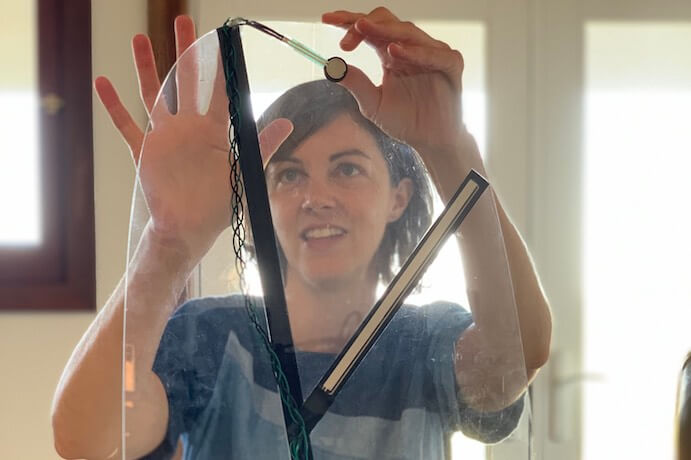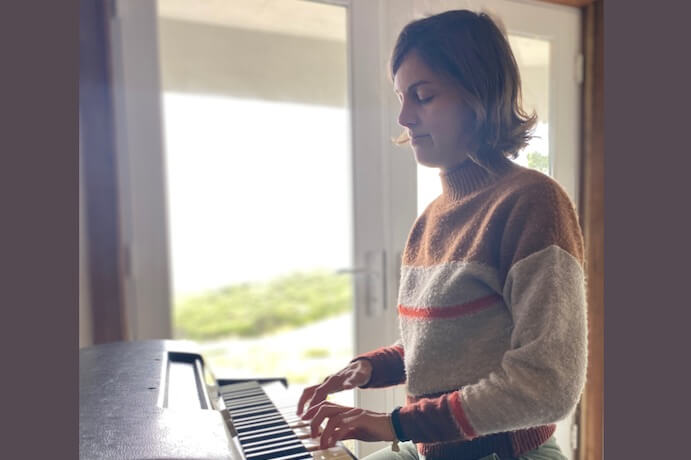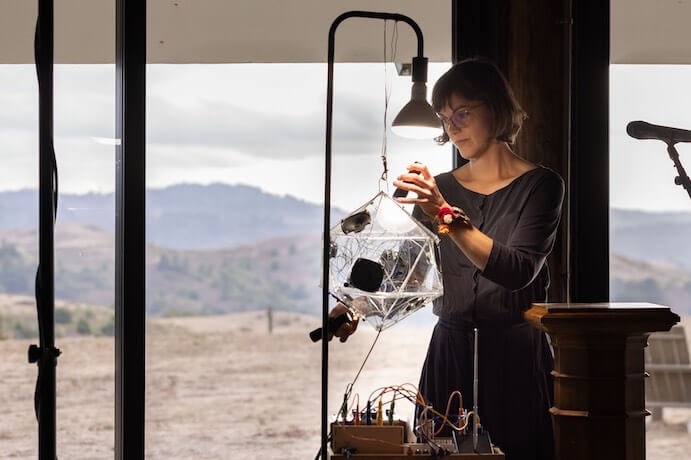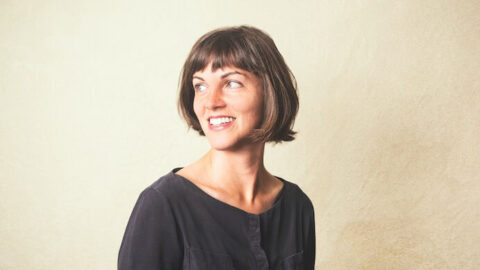This article was commissioned by American Composers Forum.
Artists require substantial support. Because the road to a viable career is not linear and can be frankly daunting, having access to resources like those American Composers Forum extends cultivates a foundation fertile with expansion, experimentation, and sustainability. What this looks like varies from creator to creator, but for Julie Herndon, a San Francisco-based composer, performer, and sound artist, support from ACF has manifested as PR guidance, monetary support, and the opportunity to redefine what an album looks and sounds like.
Herndon says that ACF’s Bay Area Composer Residency and innova Recordings’ Bay Area Pilot Program have given her a lot of opportunities to think about how she is involved in her local community, which is central to her work exploring the body’s relationship to modalities like musical instruments and personal technologies. But before emerging as an artist at the intersection of musicology, physiology, and technology, Herndon was a young girl growing up in rural southern Maryland in a family she describes as not a “classical music family.” So music wasn’t innate – it was acquired.
“My dad really liked bluegrass music,” Herndon says, “so there was a lot of love for music, but I didn’t grow up going to the symphony or things like that, or like an opera or something.”
But this didn’t dampen her fire. She was curious. And like any young child, she began exploring. Herndon’s connection with music began when she discovered she had an obsession with whistling, which led her to believe maybe playing the flute would be a catalyst for learning music. Her mom, not knowing a thing about the flute or how to nail down a teacher to nurture this desire, suggested piano lessons instead.

“We went to this church and she knew a piano teacher there,” Herndon says, “a lady that taught piano, and I think she literally just didn’t know anybody that taught flute. So, she had no idea what to do with the information. Like, ‘Oh, you want flute lessons. I don’t know anybody who plays the flute.’ But she did know somebody that played the piano, and so, that was like the next equivalent.”
Her little Casio keyboard sat on a desk where she would receive piano lessons. Her mom would even incentivize her to play by giving her the option of doing the dishes or practicing the piano. She always chose practice, which made for substantial improvement. But at a certain point, she stopped playing the piano and started writing music.
“I felt like [the piano] was this big machine,” says Herndon, “I never really connected with it the way that I wanted to, and I really, really tried…So, part of me wonders, I wonder if I played the flute if I would have really connected with that instrument and kind of continued performing.”
This doesn’t take away from her love for the piano, but it did make her curious about the parts of herself that were lost, and if the proper time had been taken to nurture those aspects, how life would differ. But this separation wasn’t all bad: her relationship with the piano led her to unearth new ways to compose music, connect back to the body, and use it in its fullness as a tool in the creation process.
She made this discovery after moving from San Francisco to New Mexico for a while to “figure out the next thing.” Isolation took her from teaching piano lessons, dog walking, and going to the conservatory to building her first musical instrument, which was this “huge domed string instrument that you stand inside.”

“It was like a walk-in piano that you could play with your whole body by dancing, and that kind of started this whole journey down this path of like, how can we be more embodied as musicians and how can we – instead of just pushing buttons on this big piano machine – how can we really, like, engage with sound and the thing that’s around us,” Herndon says.
A portal opened for Herndon that day, a portal that not only provided agency over her own body in relation to music but also gave her the ability to extend that agency to her local community through a project entitled Soundvoice. Conceived by former Executive Director of the San Francisco Contemporary Music Players, Rozella Kennedy, Herndon’s reiteration of this project won her the $10,000 Bay Area Composer Residency award from ACF to engage artists experiencing homelessness in San Francisco’s Tenderloin neighborhood through workshops and the creation of a multi-media concert featuring their stories and creativity.
The funding from ACF supplied each participating Soundvoice artist with their own field recorder, studio monitoring, in-ear headphones, contact and inductor microphones, and a stipend for their time and work. Once the creation process concluded, artists received video and audio documentation of their final piece, “a lasting feature of all the Soundvoice programs.”
“Walking to and from the Civic Center BART station, the streets are crowded with makeshift housing, tents, and hangouts,” Herndon says. “It was for that reason that I approached [Center for New Music] Executive Director Brent Miller about possible programming that could bring together these two communities: the artists frequenting the Center for shows, and the folks that live right outside.”

This innovative and perceptive programming is only the tip of the iceberg when looking at Herndon’s impact with ACF. As part of the innova Recordings Bay Area pilot program, she is in the process of materializing Breathing, Remembering, Dissolving, a collaborative record between the Kukuruz Quartet (Simone Keller, Philip Bartels, Duri Collenberg, Lukas Rickli), and composers Hassan Estakhrian, Seán Ó Dálaigh, Manuel Pessôa de Lima, Marcel Zaes, and herself.
The project is a “manifold collection of contemporary experimental musical perspectives” that all seek to challenge the idea of the body’s role in a musical performance. At the same time, it’s a collection of five works by young composers of various backgrounds – gender and racial identities and diverse musical styles – coming from the San Francisco Bay Area, United States, Latin America, and Europe.
“I hope that people can become more aware of their own bodies while they are listening,” says Herndon. “So, I would hope sometimes just by listening to someone else breathe or become attuned to their body, we can come to do that in sympathy or empathy, sympathetic response. And I hope…that it brings some peace and some kind of body sense of relaxation.”
Giving birth to a project of this magnitude and intention can feel like an insurmountable task when considering what it takes to go from concept to distribution. But innova Recordings is stepping in to provide the infrastructure for releasing the work with accompanying promotional materials and ideas, while Herndon is drawing from her network to create album art or to do liner notes. She says the innova pilot program and the Bay area residency have challenged her to look critically at what she’s creating, and how that can expand beyond the present day. The path that once seemed insurmountable has a guidepost, and the reality of being a full-time artist, for Herndon, is tangible.
I CARE IF YOU LISTEN is an editorially-independent program of the American Composers Forum, funded with generous donor and institutional support. Opinions expressed are solely those of the author and may not represent the views of ICIYL or ACF.
A gift to ACF helps support the work of ICIYL. For more on ACF, visit the “At ACF” section or composersforum.org.
























